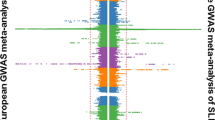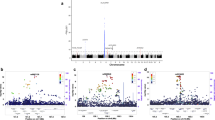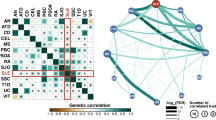Abstract
Systemic lupus erythematosus (SLE; OMIM 152700) is a genetically complex autoimmune disease. Genome-wide association studies (GWASs) have identified more than 50 loci as robustly associated with the disease in single ancestries, but genome-wide transancestral studies have not been conducted. We combined three GWAS data sets from Chinese (1,659 cases and 3,398 controls) and European (4,036 cases and 6,959 controls) populations. A meta-analysis of these studies showed that over half of the published SLE genetic associations are present in both populations. A replication study in Chinese (3,043 cases and 5,074 controls) and European (2,643 cases and 9,032 controls) subjects found ten previously unreported SLE loci. Our study provides further evidence that the majority of genetic risk polymorphisms for SLE are contained within the same regions across both populations. Furthermore, a comparison of risk allele frequencies and genetic risk scores suggested that the increased prevalence of SLE in non-Europeans (including Asians) has a genetic basis.
This is a preview of subscription content, access via your institution
Access options
Subscribe to this journal
Receive 12 print issues and online access
$209.00 per year
only $17.42 per issue
Buy this article
- Purchase on Springer Link
- Instant access to full article PDF
Prices may be subject to local taxes which are calculated during checkout




Similar content being viewed by others
Accession codes
References
Lawrence, J.S., Martins, C.L. & Drake, G.L. A family survey of lupus-erythematosus. 1. Heritability. J. Rheumatol. 14, 913–921 (1987).
Danchenko, N., Satia, J. & Anthony, M. Epidemiology of systemic lupus erythematosus: a comparison of worldwide disease burden. Lupus 15, 308–318 (2006).
Bentham, J. et al. Genetic association analyses implicate aberrant regulation of innate and adaptive immunity genes in the pathogenesis of systemic lupus erythematosus. Nat. Genet. 47, 1457–1464 (2015).
Han, J.W. et al. Genome-wide association study in a Chinese Han population identifies nine new susceptibility loci for systemic lupus erythematosus. Nat. Genet. 41, 1234–1237 (2009).
Yang, W. et al. Genome-wide association study in Asian populations identifies variants in ETS1 and WDFY4 associated with systemic lupus erythematosus. PLoS Genet. 6, e1000841 (2010).
Sheng, Y.J. et al. Follow-up study identifies two novel susceptibility loci PRKCB and 8p11.21 for systemic lupus erythematosus. Rheumatology 50, 682–688 (2011).
Yang, W. et al. Meta-analysis followed by replication identifies loci in or near CDKN1B, TET3, CD80, DRAM1, and ARID5B as associated with systemic lupus erythematosus in Asians. Am. J. Hum. Genet. 92, 41–51 (2013).
Li, Y. et al. Association analyses identifying two common susceptibility loci shared by psoriasis and systemic lupus erythematosus in the Chinese Han population. J. Med. Genet. 50, 812–818 (2013).
Sheng, Y.J. et al. Association analyses confirm five susceptibility loci for systemic lupus erythematosus in the Han Chinese population. Arthritis Res. Ther. 17, 85 (2015).
Yang, J. et al. ELF1 is associated with systemic lupus erythematosus in Asian populations. Hum. Mol. Genet. 20, 601–607 (2011).
Fernando, M.M.A. et al. Transancestral mapping of the MHC region in systemic lupus erythematosus identifies new independent and interacting loci at MSH5, HLA-DPB1 and HLA-G. Ann. Rheum. Dis. 71, 777–784 (2012).
Manku, H. et al. Trans-ancestral studies fine map the SLE-susceptibility locus TNFSF4. PLoS Genet. 9, e1003554 (2013).
Adrianto, I. et al. Association of a functional variant downstream of TNFAIP3 with systemic lupus erythematosus. Nat. Genet. 43, 253–258 (2011).
Mahajan, A. et al. Genome-wide trans-ancestry meta-analysis provides insight into the genetic architecture of type 2 diabetes susceptibility. Nat. Genet. 46, 234–244 (2014).
Hom, G. et al. Association of systemic lupus erythematosus with C8orf13-BLK and ITGAM-ITGAX. N. Engl. J. Med. 358, 900–909 (2008).
Raj, T. et al. Polarization of the effects of autoimmune and neurodegenerative risk alleles in leukocytes. Science 344, 519–523 (2014).
Fairfax, B.P. et al. Genetics of gene expression in primary immune cells identifies cell type-specific master regulators and roles of HLA alleles. Nat. Genet. 44, 502–510 (2012).
Nica, A.C. et al. Candidate causal regulatory effects by integration of expression QTLs with complex trait genetic associations. PLoS Genet. 6, e1000895 (2010).
Jury, E.C., Kabouridis, P.S., Flores-Borja, F., Mageed, R.A. & Isenberg, D.A. Altered lipid raft-associated signaling and ganglioside expression in T lymphocytes from patients with systemic lupus erythematosus. J. Clin. Invest. 113, 1176–1187 (2004).
Wang, C. et al. Contribution of IKBKE and IFIH1 gene variants to SLE susceptibility. Genes Immun. 14, 217–222 (2013).
Kim, K. et al. High-density genotyping of immune loci in Koreans and Europeans identifies eight new rheumatoid arthritis risk loci. Ann. Rheum. Dis. 74, e13 (2015).
Plagnol, V. et al. Genome-wide association analysis of autoantibody positivity in type 1 diabetes cases. PLoS Genet. 7, e1002216 (2011).
Medici, M. et al. Identification of novel genetic loci associated with thyroid peroxidase antibodies and clinical thyroid disease. PLoS Genet. 10, e1004123 (2014).
Tantin, D., Tussie-Luna, M.I., Roy, A.L. & Sharp, P.A. Regulation of immunoglobulin promoter activity by TFII-I class transcription factors. J. Biol. Chem. 279, 5460–5469 (2004).
Lu, L.D. et al. Depletion of autoreactive plasma cells and treatment of lupus nephritis in mice using CEP-33779, a novel, orally active, selective inhibitor of JAK2. J. Immunol. 187, 3840–3853 (2011).
Crow, Y.J. et al. Characterization of human disease phenotypes associated with mutations in TREX1, RNASEH2A, RNASEH2B, RNASEH2C, SAMHD1, ADAR, and IFIH1. Am. J. Med. Genet. A. 167, 296–312 (2015).
Günther, C. et al. Defective removal of ribonucleotides from DNA promotes systemic autoimmunity. J. Clin. Invest. 125, 413–424 (2015).
Huang, C. et al. Cutting Edge: a novel, human-specific interacting protein couples FOXP3 to a chromatin-remodeling complex that contains KAP1/TRIM28. J. Immunol. 190, 4470–4473 (2013).
Pruim, R.J. et al. LocusZoom: regional visualization of genome-wide association scan results. Bioinformatics 26, 2336–2337 (2010).
Beecham, A.H. et al. Analysis of immune-related loci identifies 48 new susceptibility variants for multiple sclerosis. Nat. Genet. 45, 1353–1360 (2013).
Maller, J.B. et al. Bayesian refinement of association signals for 14 loci in 3 common diseases. Nat. Genet. 44, 1294–1301 (2012).
Gaulton, K.J. et al. Genetic fine mapping and genomic annotation defines causal mechanisms at type 2 diabetes susceptibility loci. Nat. Genet. 47, 1415–1425 (2015).
Bernstein, B.E. et al. The NIH Roadmap Epigenomics Mapping Consortium. Nat. Biotechnol. 28, 1045–1048 (2010).
Bulik-Sullivan, B. et al. An atlas of genetic correlations across human diseases and traits. Nat. Genet. 47, 1236–1241 (2015).
O'Connell, J. et al. A general approach for haplotype phasing across the full spectrum of relatedness. PLoS Genet. 10, e1004234 (2014).
Marchini, J. & Howie, B. Genotype imputation for genome-wide association studies. Nat. Rev. Genet. 11, 499–511 (2010).
R-Core-Team. R: A Language and Environment for Statistical Computing (R Foundation for Statistical Computing, Vienna, Austria, 2013).
Willer, C.J., Li, Y. & Abecasis, G.R. METAL: fast and efficient meta-analysis of genomewide association scans. Bioinformatics 26, 2190–2191 (2010).
Li, M.X., Kwan, J.S.H. & Sham, P.C. HYST: A hybrid set-based test for genome-wide association studies, with application to protein-protein interaction-based association analysis. Am. J. Hum. Genet. 91, 478–488 (2012).
Li, M.X., Gui, H.S., Kwan, J.S.H. & Sham, P.C. GATES: a rapid and powerful gene-based association test using extended Simes procedure. Am. J. Hum. Genet. 88, 283–293 (2011).
Li, M.X., Sham, P.C., Cherny, S.S. & Song, Y.Q.A. Knowledge-based weighting framework to boost the power of genome-wide association studies. PLoS One 5, e14480 (2010).
Goecks, J., Nekrutenko, A., Taylor, J. & Galaxy, T. Galaxy: a comprehensive approach for supporting accessible, reproducible, and transparent computational research in the life sciences. Genome Biol. 11, R86 (2010).
Hughes, T. et al. Analysis of autosomal genes reveals gene-sex interactions and higher total genetic risk in men with systemic lupus erythematosus. Ann. Rheum. Dis. 71, 694–699 (2012).
Yang, J., Lee, S.H., Goddard, M.E. & Visscher, P.M. GCTA: a tool for genome-wide complex trait analysis. Am. J. Hum. Genet. 88, 76–82 (2011).
Acknowledgements
P.T. is employed by the Biomedical Research Centre. L.C. was funded by the China Scholarship Council (201406380127). The research was funded/supported by the National Institute for Health Research (NIHR) Biomedical Research Centre based at Guy's and St Thomas' NHS Foundation Trust and King's College London. T.J.V. was awarded funding to carry out genotyping and analysis from G. Koukis, an Arthritis Research UK Special Strategic Award, and the Wellcome Trust (grant 085492). T.J.V. was awarded funding by the MRC (L002604/1, “Functional genomics of SLE: a transancestral approach”). Y.C., X. Zhang, S.Y. and Y.S. acknowledge support from the Key Basic Research Program of China (2014CB541901, 2012CB722404 and 2011CB512103), the National Natural Science Foundation of China (81402590, 81371722, 81320108016 and 81171505), the Research Project of the Chinese Ministry of Education (213018A), the Program for New Century Excellent Talents in University (NCET-12-0600) and the Natural Science Fund of Anhui Province (1408085MKL27). W.Y. and Y.L.L. acknowledge support from the Research Grant Council of the Hong Kong Government (GRF HKU783813M, HKU 784611M, 17125114 and HKU 770411M). Y.Z. thanks the Health and Medical Research Fund (12133701) from the Food and Health Bureau, Hong Kong. We thank T. Raj and P. De Jager for contributing gene expression data (CD4+ T cells and CD14/16+ monocytes in Asian and European populations; available in the NCBI Gene Expression Omnibus under accession number GSE56035). We thank B. Fairfax and J. Knight for contributing gene expression data on NK cells, naive monocytes, LPS-stimulated monocytes (harvested after 2 h and 24 h), interferon and B cells. We thank S. Daffern for downloading the ChIP-seq data in contribution to the epigenetic analysis.
For the replication study in Europeans, samples were provided by the Swedish SLE Network (led by L.R.). Replication genotyping was performed by the SNP&SEQ Technology Platform in Uppsala, which is part of the Swedish National Genomics Infrastructure (NGI) hosted by Science for Life Laboratory. The controls for the European GWASs and replication were obtained from dbGaP accession phs000428.v1.p1 (a study sponsored by the National Institute on Aging (grants U01AG009740, RC2AG036495 and RC4AG039029) and conducted by the University of Michigan); melanoma study data under dbGaP accession phs000187.v1.p1; a blood clotting study (dbGaP accession phs000304.v1.p1); and prostate cancer study data under dbGaP accession phs000207.v1.
The French cases for the European replication study were provided by the PLUS study, funded by a grant from the French PHRC 2005 Ministère de la Santé (ClinicalTrials.gov: NCT00413361 to N.C-C.). Participants were F. Ackermann, Z. Amoura, B. Asli, L. Astudillo, O. Aumaître, C. Belizna, N. Belmatoug, O. Benveniste, A. Benyamine, H. Bezanahary, P. Blanco, O. Bletry, P. Bourgeois, B. Brihaye, P. Cacoub, E. Chatelus, J. Cohen-Bittan, R. Damade, E. Daugas, C. De-Gennes, J.-F. Delfraissy, A. Delluc, H. Desmurs-Clavel, P. Duhaut, A. Dupuy, I. Durieu, H.-K. Ea, O. Fain, D. Farge, C. Funck-Brentano, C. Frances, L. Galicier, F. Gandjbakhch, J. Gellen-Dautremer, B. Godeau, C. Goujard, C. Grandpeix, C. Grange, G. Guettrot, L. Guillevin, E. Hachulla, J.-R. Harle, J. Haroche, P. Hausfater, J.-S. Hulot, M. Jallouli, J. Jouquan, G. Kaplanski, H. Keshtmand, M. Khellaf, O. Lambotte, D. Launay, P. Lechat, D.L.T. Huong, V. Le-Guern, J.-E. Kahn, G. Leroux, H. Levesque, O. Lidove, N. Limal, F. Lioté, E. Liozon, L.Y. Kim, M. Mahevas, K. Mariampillai, X. Mariette, A. Mathian, K. Mazodier, M. Michel, N. Morel, L. Mouthon, J. Ninet, E. Oksenhendler, T. Papo, J.-L. Pellegrin, L. Perard, O. Peyr, A.-M. Piette, J.-C. Piette, V. Poindron, J. Pourrat, F. Roux, D. Saadoun, K. Sacre, S. Sahali, L. Sailler, B. Saint-Marcoux, F. Sarrot-Reynauld, Y. Schoindre, J. Sellam, D. Sène, J. Serratrice, P. Seve, J. Sibilia, C. Simon, A. Smail, C. Sordet, J. Stirnemann, S. Trad, J.-F. Viallard, E. Vidal, B. Wechsler, P.-J. Weiller, and N. Zahr.
Y.L.L. is thankful for generous donations from Shun Tak District Min Yuen Tong of Hong Kong that partially supported the SLE GWAS in Hong Kong. Y.L.L. and W.Y. thank the doctors who contributed SLE cases and colleagues in the LKS Faculty of Medicine, University of Hong Kong, who provided controls used in the GWASs.
Author information
Authors and Affiliations
Contributions
Y.-F.W., Z.Z. and P.T. contributed equally to this work. T.J.V., X. Zhang, Y.C., Y.L.L. and W.Y. supervised the study. Z.Z., L.W., C.Y., L.L., L.Y., F.L., Y.H., X.Y. and S.Y. performed sample selection and data management, undertook recruitment and collected phenotype data for the Anhui Chinese data. L.R., B.G.F., R.E.V., G.S., N.C.-C. and P.M.G. performed sample selection and data management, undertook recruitment and collected phenotype data for the European data. A.L.R. and Y.S. worked on genotyping of both Chinese and European replication studies. D.L.M., Y.S., Y.Z. and Y.-F.W. carried out statistical analysis of the GWAS data. D.L.M. and P.T. carried out the 1000 Genomes Project imputation in the European GWAS. Y.S., X. Zuo, R.C. and T.W. carried out the 1000 Genomes Project imputation in the Anhui and Hong Kong Chinese GWASs. D.L.M., P.T., Y.S., X. Zuo, Y.-F.W. and Y.Z. carried out statistical analysis for the meta-analysis of the 1000 Genomes Project imputed data. D.L.M., Y.S. and Y.Z. designed the replication studies' chips. B.G.F. and R.E.V. contributed data to the European replication cohort. D.L.M. and J.B. performed quality control on the European data for the replication study. D.L.M. analyzed European replication data. D.L.M., Y.S. and Y.Z. analyzed Anhui replication data. Y.-F.W. and D.L.M. designed and performed genetic risk score comparison between the populations. Y.-F.W. performed the LD score regression analysis. D.L.M. and L.C. carried out the eQTL analysis. D.L.M. and D.S.C.G. carried out the epigenetic analysis. D.L.M., T.J.V., D.S.C.G., X. Zhang, Y.C., Y.S. and W.Y. wrote the manuscript. All authors read and contributed to the manuscript.
Corresponding authors
Ethics declarations
Competing interests
The authors declare no competing financial interests.
Supplementary information
Supplementary Text and Figures
Supplementary Figures 1–9, Supplementary Tables 1–5, and Supplementary Notes 1–3 (PDF 8289 kb)
Supplementary Table 6
SNPs contained with the credibility sets for the newly discovered loci that also had peaks of chromatin marks (XLSX 38 kb)
Supplementary Table 7
The imputation quality information (XLSX 55 kb)
Rights and permissions
About this article
Cite this article
Morris, D., Sheng, Y., Zhang, Y. et al. Genome-wide association meta-analysis in Chinese and European individuals identifies ten new loci associated with systemic lupus erythematosus. Nat Genet 48, 940–946 (2016). https://doi.org/10.1038/ng.3603
Received:
Accepted:
Published:
Issue Date:
DOI: https://doi.org/10.1038/ng.3603
This article is cited by
-
Genetics of SLE: mechanistic insights from monogenic disease and disease-associated variants
Nature Reviews Nephrology (2023)
-
Molecular pathways identified from single nucleotide polymorphisms demonstrate mechanistic differences in systemic lupus erythematosus patients of Asian and European ancestry
Scientific Reports (2023)
-
Proteomics analysis of lysine crotonylation and 2-hydroxyisobutyrylation reveals significant features of systemic lupus erythematosus
Clinical Rheumatology (2022)
-
Recent advances in understanding the genetic basis of systemic lupus erythematosus
Seminars in Immunopathology (2022)
-
B Cell Aberrance in Lupus: the Ringleader and the Solution
Clinical Reviews in Allergy & Immunology (2022)



